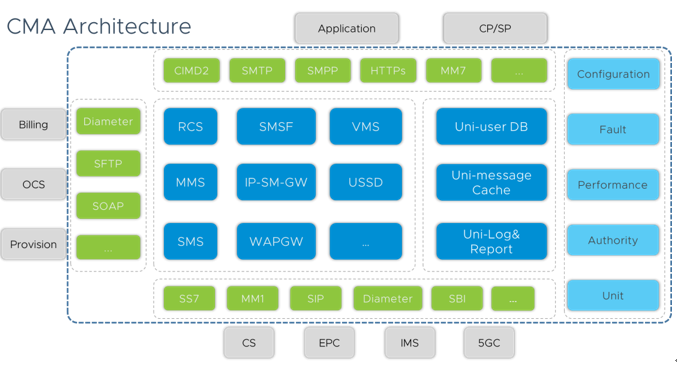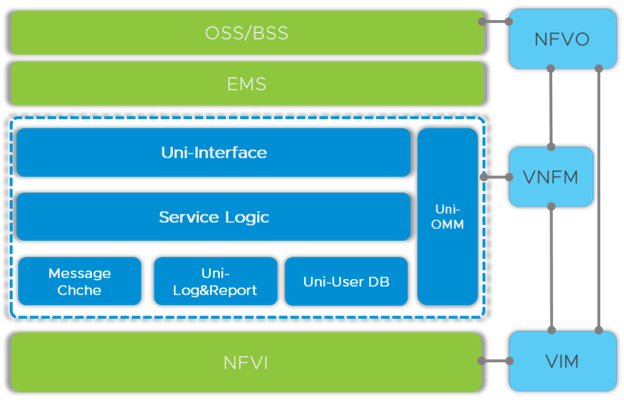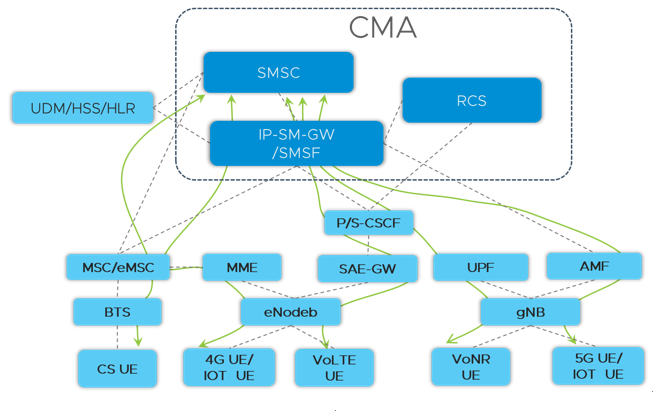27 years ago, the world's first short message was sent successfully, marking the beginning of the mobile message communication capability. In addition to voice, it provides another fast and convenient communication method.
The evolution of the global mobile network has witnessed the rapid development of 2G to 5G. Messages have also evolved from single text messages to multiple types of message services such as multimedia messages, providing users with voice mailboxes for leaving messages, facilitating users to query USSD of bill traffic, and supporting RCS messages of rich media communication and chat robots. The message communication mode evolves from man-to-man, to application-to-man, and then to thing-to-thing communication.
To adapt to the ever-changing market, ZTE has proposed the CMA (Converged Message Architecture) converged message solution to integrate all message service platforms in the operator network. It flexibly implements the capabilities of each service engine in a modular and MicroService manner. Based on the NFV cloud architecture, CMA maintains the features of the existing message services, implements rapid service deployment, and provides elastic resource scalability, thus reducing the construction costs of operators. By using the big data technology, CMA implements fast log collection and analysis, thus reducing operators' operation and maintenance costs.

Figure 1 CMA Software and Interface Architecture
2G/3G/4G/5G fully converged message
In the traditional network architecture of an operator, different message services provide different user experience, and different message services construct different architectures and platforms. With the change of user habits, the functions of various message services are overlapped more seriously, and the maintenance costs of multiple platforms are greatly increased.
CMA provides a fully converged message platform. The same modules share resources or are deployed in a centralized manner, thus reducing the investment and construction cost of operation, and giving subscribers more flexible service choices. It provides various messages from 2G to 5G network, including such message service NEs as SMSC, MMSC, WAPGW, USSD, VMS, MissCall, IP-SM-GW, RCS and SMSF. CMA provides various message services.
Support for NFV and Cloud Native

Figure 2 CMA NFV Architecture
Based on the NFV fully cloudified architecture, CMA supports separation of software from hardware, and separation of status from processing logic. Through ZTE's CloudStudio + TECS products, CMA implements flexible and fast service deployment and elastic service capability scalability.
With the separation of hardware from software, operators can purchase devices in a centralized manner for data center construction, reducing the waste of independent devices of each product.
The fast instantiation of VNF reduces the complicated installation and configuration debugging in the CT industry, implements planning in advance, and makes one-click installation. This feature greatly reduces engineering delivery time, implements rapid provisioning of services, and helps operators gain more market time.
Elastic service capability scalability and real resource sharing are implemented so that poor-developed services can release resources for better-developed services, reducing the extra investment of operators.
The NFV solution of CMA can be upgraded through Cloud Native.
Multi-tenant and multi-country architecture
In recent years, operators generally require efficient use of resources to reduce idle resources. Major operators often use the centralized construction mode of DCs in a big region, and multinational operators select the multi-country solution with multiple branches for centralized construction. The multi-tenant and multi-country operation model is a good choice.
CMA is designed based on the real multi-tenant architecture to separate tenants' services, configurations, from data. Each tenant has its own service logic, configuration, O&M, and management interfaces. To isolate tenants inside the message service platform, CMA can share or exclusively occupy different resources. In this way, the best solution can be selected for the operator in terms of resource sharing, isolation, complexity, and occupancy cost.
Big capacity, high reliability and smart O&M
Based on the expansion architecture of big data technology, distributed computing, and distributed storage, the CMA architecture meets the large-capacity requirements of the system, and ZTE is experienced in deploying and operating massive-capacity sites to support more than 100 million subscribers in each site.
High reliability: Data is duplicated on multiple storage servers. Even if one of the storage servers breaks down, the big data cluster can operate properly. When a storage server is repaired or added to a cluster, the cluster can distribute data copies without reducing work. Each node in a big data cluster is not affected when the cluster is expanded.
Real-time and rapid: Distributed message queues push messages to big data clusters in real time. The maintenance GUI allows users to collect, and make intelligent analysis of data rapidly and in real time, providing intelligent O&M and operation support.
Easy maintenance: The big data cluster supports graphical maintenance interfaces, such as the status of the data processing service or job monitor, node alarm breakdown, and CPU/memory/disk resource shortage. With this feature, you can easily monitor clusters, nodes, services, and jobs, and rapidly detect unbalanced loads of data process, abnormal faults, services, and jobs.
5G network compatible from top to bottom

Figure 3 CMA Provides Multiple Mobile Network Message Solution
From 2G to 5G, it is a step-by-step process for operators to invest and construct networks. The network coverage rate of lower versions will be higher than that of higher versions. Therefore, users may fall back to networks with good signals, so the product needs to support multiple network access modes and domain selection.
The CMA message platform is compatible with the network and develops continuously. It can support service communication between different networks. Messages can be processed in 2G/3G network, 4G/LTE network or 5G network. In addition, different domains can be selected for services. Take SMS as an example, it supports MAP of 2G/3G, SMS in MME (Diameter), SMS over IP (SIP) and SMS over NAS (SBI).
With the development of mobile communications, the CMA converged message solution will enter the 5G era to change the society and Internet of Everything. This solution will help operators smoothly put 5G networks into commercial use. It will provide more flexible functions, easy-to-use, fast deployment, low cost, and compatible message products for multiple networks.
ZTE supports AI with full-stack IT offering
5GC Green Engine Solution to Enable Green Internet of Everything in the Dual-Carbon Era
5GC Private Network 2.0 Empowerment and Efficiency Improvement Boosts High-Quality Development of the Industry
5G Empowers Intelligent Mining for High-quality Development of Shaanxi Coal Caojiatan Mining
ZTE and China Mobile embrace digitalization for biodiversity conservation in Panda Reserve
Three Aspects Contribute to ZTE’s Remarkable Breakthroughs in Advanced G4X Server
How 5G Private Networks Are Poised to Transform Enterprises Worldwide: All Scenario Private 5G Helps Operators to Realize Private 5G as a Service
ZTE’s commitment to servers generates robust growth of up to 60 times in past 8 years
ZTE eyes top 5 global server market share
Full-Scenario One-Stop 5G Private Network for Vertical Industries

